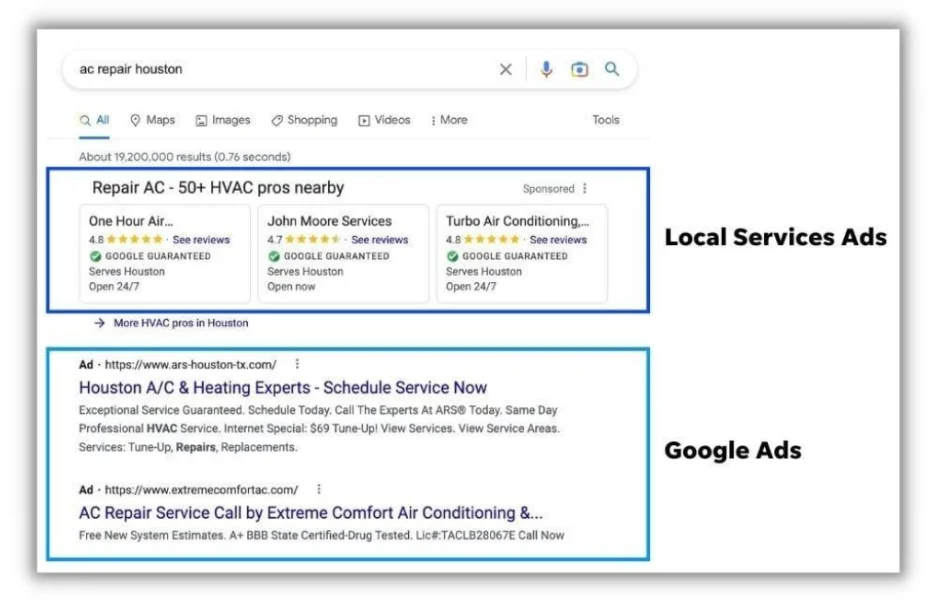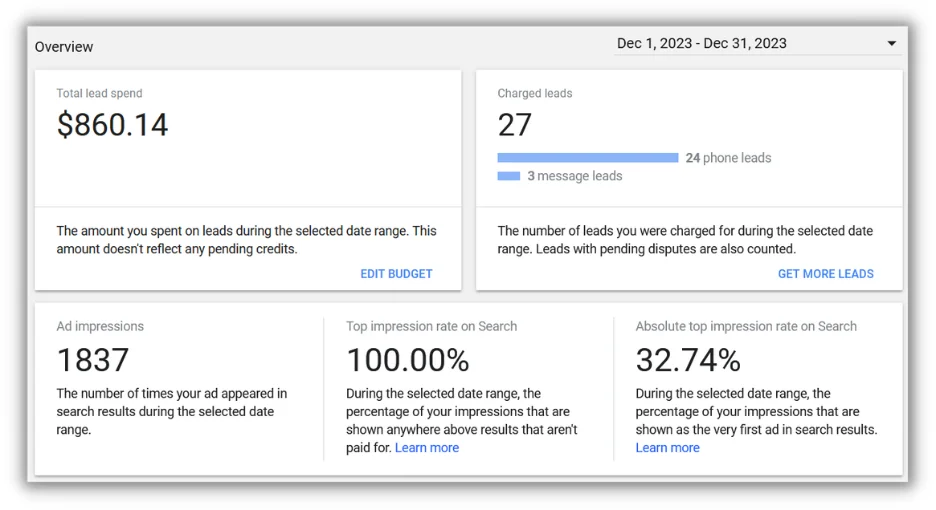Location matters when you’re searching online. Whether you’re searching for a plumber, repairman, or even a lawyer–we aren’t looking to connect with someone several states away. Optimizing your business to show for these local searches is critical–and since 2015, many advertisers have taken advantage of Google’s Local Services Ads as part of their strategy to be found by customers in their area.
However, Google previously offered little data or insight into how often Local Services Ads (LSAs) were shown on the SERP, and advertisers had very little opportunity to troubleshoot and optimize their LSAs. Thankfully, Google recently started sharing new ad impression and impression share metrics with advertisers which can help guide you to make the most of your Local Services Ads.
Table of contents
What are Google Local Services Ads?
Google Local Services Ads are a simple (and safe!) way to connect local searchers to professionals in their area. This unique local ad format highlights locally screened professionals that are ready to take on their job at the very top of the SERP. Over the years, Google has opened these Local Services Ads to over 80 different local industries–from home services, car repair, pet care, accountants, lawyers, and more. Local Services Ads are available in the US, Canada, the United Kingdom, and several European countries.
Local Services Ads appear above the traditional paid search ads and organic listings–and advertisers can take advantage of running both LSAs and traditional PPC ads simultaneously, often showing up twice for the same search.


Unlike traditional paid search ads though–Local Services Ads have no keywords or negative keywords to manage. LSA advertisers simply select the types of jobs they want to show ads for, and Google matches your listing to relevant search terms. Additionally, Google Local Services Ads charges advertisers a fee for each lead (usually a call or message) from their ads, whereas traditional paid search campaigns charge advertisers for each ad click to their website’s landing page, regardless of whether they contact that business.
? Worried you’re wasting spend in Google Ads? Find out with a free, instant audit >> Google Ads Performance Grader
New Google Local Services Ads metrics
Previously, Local Services advertisers could review very limited data on their ads’ performance. You can view your leads and your total costs during any given time frame–but apart from that, very little else. Since November 2023, Google has been rolling out new impression and Impression rate metrics for your Local Services Ads. Advertisers can view these metrics under the “reports” tab in the left-hand menu of the Local Services Ads interface.


Local Services Ads now include metrics for your ad impressions, top impression rate on search, and absolute top impression rate on search.
? What results can you expect from Google Ads? Download our latest Google Ads Benchmarks to find out!
Ad impressions
Simply put, ad impressions tell you how many times your LSAs were shown on the SERP. Getting seen on Google is important and your ad impressions is a metric to quantify your ads’ visibility.
But like other search ad formats–most people who see your ad won’t click or become a lead. That’s fine and expected–and you don’t pay Google every time your LSAs show, only when someone clicks and becomes a lead.
Here are some ways to use the ad impressions metric.
Troubleshoot your LSAs
Previously, it could be tough for small businesses to know if their ads were even running if they weren’t getting leads. If you see zero ad impressions, that’s a sign that something with your profile isn’t set up correctly, or that your ads are paused.
Understand your reach
Lots of SMBs generally start their advertising campaigns small. That’s understandable, but oftentimes they reach a much smaller audience than they expected and get disappointed. This additional insight into the reach of your LSAs may encourage you to expand your targeted locations or include more job types in your listing.
Improve your LSA engagement
Remember that the average search ad CTR is only 6%! And unlike search ads, Local Service Ads push searchers to call or message the provider directly. As a result, LSAs may have far less engagement than the links from your search campaigns. You may only see that 0.2% of your ad impressions turn into a lead!
You can use your leads/impressions ratio as a proxy metric for your LSA engagement. If you see that people are seeing your LSAs but not engaging, it may be a sign that your LSA profile could use a refresh. Simply updating your business bio with new, competitive offers or uploading a fresh high-quality photo or headshot can make a huge difference in improving your Local Service Ads.
?? Is your Google Ads account set up for success? Download now >> The Last Guide to Google Ads Account Structure You’ll Ever Need
Top impression rate on search
Top impression rate on search tells you how often your LSAs show above the organic search results. The top impression rate on search is calculated as:
Search top impression rate = Impressions on top/Impressions
Local Services Ads nearly always appear above the organic results. In my experience, this metric has always been 100% for my advertisers–but it wouldn’t surprise me if Google was including this metric because it plans to start testing LSAs in different positions of the SERP or within its new Search Generative Experience.
Bear in mind though–this metric is NOT the same as search impression share, which measures how frequently your ad showed for relevant searches. Just because your ad is showing at the top doesn’t mean that you aren’t missing potential ad impressions due to low budgets or poor ranking.
Absolute top impression rate on search
Absolute top impression rate on search tells you how often your LSAs show in the very first spot on the SERP. Absolute top impression rate on search is calculated as:
Search absolute top impression rate = Impressions in the first spot /Impressions
Here are some ways you can use this metric.
See how competitively your LSAs are performing
Being in that very first spot will get you a lot of reach, attention, and engagement. But it can also be very expensive. If you see a low absolute top impression rate, it may be a sign to increase your bids. But if you see a higher top impression rate, be sure that you’re comfortable with your current cost per lead. There’s no shame in being in a lower position if you can afford more profitable leads.
Guide your LSA budget decisions
Google allows businesses of all sizes and budgets to run LSAs–allowing them to set a weekly budget for their ads to run across the SERP. However, small businesses often fall into a trap–they’re overly excited about showing up in that absolute top position but also have a relatively small budget.
Consequently, they can only afford a few (very expensive) leads before they run out of budget. It’s much better to afford more leads in a lower position at a better cost per lead when managing an LSA on a smaller budget.
If you’re consistently spending your weekly LSA budget and also have a high absolute top impression rate on search, you’re likely missing out on a lot of opportunities for your ads to show. Consider either increasing your budget or decreasing your bids if you run into this dilemma.
To help benchmark what leads for your business cost on LSAs, consider using Google’s LSA budget estimator tool.


? Want to learn more about search engine marketing on Google? Get the free guide >> PPC 101: Complete Guide to Google Ads
Start using Google Local Services Ads new metrics
Google’s new impression and impression rate metrics for Local Services Ads can help provide helpful insight into managing these campaigns. Advertisers can see the costs and leads of their LSA campaigns and begin to understand how their LSAs reach searchers and how best to optimize them.